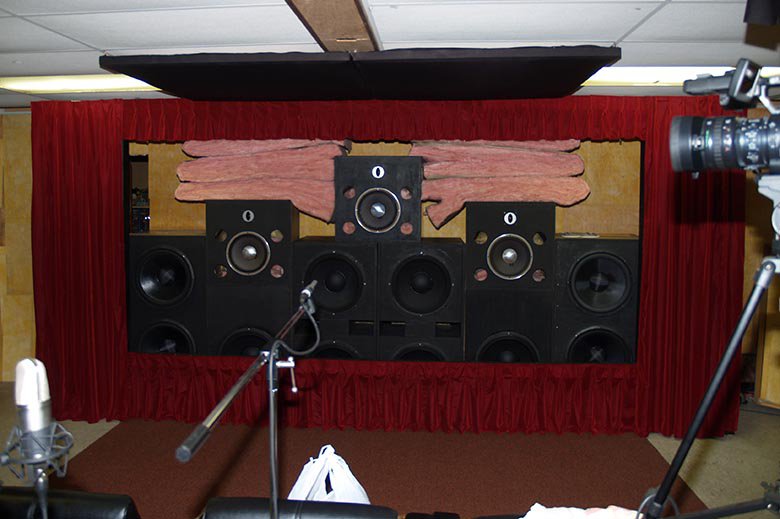-
Posts
162 -
Joined
-
Last visited
-
Days Won
5
basspig last won the day on May 2 2014
basspig had the most liked content!
Personal Information
-
Location
New Milford, CT
- Homepage
Recent Profile Visitors
The recent visitors block is disabled and is not being shown to other users.
basspig's Achievements

Power Diode (8/21)
62
Reputation
-
The one that's drifted off into the realm of 'snake oil' subjective evaluations of sound quality. ?
-
With internal tube resistance being hundreds to thousands of ohms, there's simply no way a tube can be a better voltage source than a transistor, whose ability to deliver current is at least two orders of magnitude greater than that of any common audio output tube.
-
I read briefly through the whitepaper and I get your point, but I disagree that a good voltage source amplifier is large and expensive. And with class G/H designs, efficiency is pretty good nowadays. Class A is the pig in the room as far as efficiency, and for that, high power output is going to be costly in terms of cooling and power consumption. It's been known for over 50 years that speakers designed during the tube era sound 'dead' on SS amps. It's as you say, because the tube amp will increase its voltage output at the resonance of the speaker and maintain almost constant power to the load that is varying in impedance across the frequency band. Modern speakers are designed to work with modern amplifiers though. I was an all tube guy for many years. I held out until the late 1970s with my home brew tube monoblocks. Nothing sounded fatter, played as loud, or seemed as tolerant of overdrive as my tube amps. My first SS amp was a Fisher TX200. It crackled when it ran out of gas. Years later, someone loaned me a 40wpc Dynaco SS amp. Same thing. Seemed to lack bottom end. In the late 1970s, I picked up a Marantz 2270. For sure, this should have more bass. It didn't. It sounded grainy, thin and brittle and when driven hard, it would oscillate and that would manifest as audible clicks or chirps in the tweeters. A year later, I brute-forced it and got a PL D-500. That broke the barrier, but it wasn't perfect. It wasn't until 1984, when the MOSFET amplifiers came along, and would finally replicate the clip tolerance of my tube amps, while offering much wider bandwidth and power. Now those Lowther speakers are interesting, but they come with a great many (and ridiculous) compromises. The size of the horns, just to get down to 50Hz, and the problems of intermod using a single driver across the whole band. Well, they're probably okay if playing string quartet music, but pipe organ, or marching band music? I don't think so. My experience with seeking out amplifiers for reproducing low frequencies has taught me that for power efficiency and woofer control with exceedingly low distortion, a transistor amp is the way to go. Nowadays, I run industrial amplifiers which can work all day into 1Ω loads without strain and damping factors in excess of 2000. And I do get Nelson's point about overdamping. I did lose some bass by going to the much higher gauge wire. But the bass I have now is more accurate without the boom. If I were to try to recreate my present system with vacuum tubes, I would need 15 tons of air conditioning capacity and a direct feed from Niagara Falls. I simply could not even afford to turn on the system for one hour. The present system is clean, quiet, cool-running and relatively maintenance-free. I could never see myself going back to vacuum tubes.
-
I think you have it backwards. A voltage source will (theoretically) try to deliver infinite current into a dead short, whereas a current source will try to maintain the current flow at the same value in to a range of load impedances. An ideal voltage source has zero internal resistance so that changes in external load resistance will not change the voltage supplied. An ideal current source has infinite resistance so that changes in external load resistance will not change the current supplied. A well designed transistor amplifier will be relatively unaffected by the load, within the limits of its design. Such an amplifier has some commonalities with the pass bank of a regulated power supply. Of course, some feedback is necessary to maintain the regulation of a DC supply, and the same holds true for a circuit used in audio amplification.
-
Vacuum tube amps, due to their high output impedance making them current sources, are affected drastically by the impedance curve of the load/loudspeaker. Solid state amplifiers, especially the more massively parallel ones with large numbers of output devices, appear as being close to a pure voltage source. They are nearly impervious to the changing load impedances of a loudspeaker. Some early SS amplifiers of poor design also behaved in unexpected ways, such as breaking into oscillation, with certain loads.
-
This one's an HP 3580A. Got it for $212 on eBay and refurbished it myself (mostly cosmetic fixes). How much did you spend for the 3585A?
-
I switched out the ext proc loop and the Sonic Hologram, swapped the Behringer ECM8000 mic for the B-1 mic, and with 20Hz @ 110dB, the total harmonic distortion reading of the Bassmaxx woofers in operation shows 0.27% on the Tektronix AA501.
-
Interesting contrast.. just measured my Dynaudio Acoustics speakers.. 9-1/4" long-throw woofers. 20Hz test signal, 3 watts power level, 90dB SPL attained on Cel 201/1 meter. 29.9% THD on Tektronics AA501.
-
I've been analyzing my test setup and have found some alternative wiring methods to get the 60Hz hum down another 20dB. In the process, I took distortion measurements on the AA501 analyzer and found that the mixer, preamp I'm using contributes .03% distortion itself. I am now taking the pre-EQ/Fader output to get rid of some noise and distortion. Another issue is the blocking capacitor downstream of the phantom 48VDC.. it's dropping the fundamental output because the response rolls off somewhat by 20Hz. (the 90Hz should be 80Hz --typo) At least the setup is much cleaner now, and I measured the noise with the mic plugged in, and it is -84dB below preamp clipping, which represents 0dB at the top of the HP 3580A display. The noise floor is showing about -90dB at frequencies other than 60Hz. As soon as I can get everyone out of the house, I'll conduct a followup test. Also try some different mics to see which mic has lower distortion.
-
Ah, indeed they are loafing.. probably about 1W of input power to achieve those levels. David Lee, at Bassmaxx told me that when the lab in Pennsylvania did the Thiel-Small parameter testing, they got some incredible results, such that it prompted a call from the testing lab to David to discuss the unusual results. The BL is flat to about 3" of peak to peak excursion (Xmech is even higher at 3.6"), and the lab's test results indicated that with the rated 3600W of input power, the calculated SPL @20Hz would be 154dB. Since these were designed for use in a horn loaded system, I would presume those figures are for a horn loaded application. Power compression was said to be about 1dB at full power, which is also unusual, but then the drivers were built to rock football stadiums, not livingrooms, and as such are in a different league than what we're normally used to. I figured out that my limiting factor was ambient noise. I've got about 75dB between the 110 and the 35dB ambient noise floor. That sets a theoretical low limit in the THD measurements. The microphone is the other unknown, since I know that at 1KHz it's 1% with something like 133dB, but that's probably the frequency where distortion is lowest. Just how much it rises as freq goes down, who knows. Also, those ECM8000 mics roll off several dB below 30Hz, so by 20Hz they may be less sensitive to the fundamental and more sensitive to the noise and harmonics. And finally, at -60dB is that 60 cycle hum. It's still there after I shut down the sound system, and appears to be a ground loop between mixer preamp and test equipment. I'll attempt this test again soon, after exploring alternative wiring methods to reduce the hum. The hum puts a hard lower limit of 0.1% THD+N on the readings. Add in room noise, room rattling/distortion, mic distortion, etc., and a lot of what I'm measuring isn't loudspeaker distortion at all.
-
Very interesting test.. 20 Hertz signal, driven to Bassmaxx ZR18s, SPL of 110dB as measured on SPL meter. Behringer ECM8000 omni capsule mic measuring the sound, fed to Behringer MX1804X mixer, output of which drives Tektronix AA501 Distortion Analyzer and HP 3580A Audio Spectrum Analyzer. Not taking into account hum and noise, the distortion reading (unweighted) is 0.4%. On the spectrum analyzer, with the test signal stopped, there is 60Hz hum at -60dB, accounting for at least 0.1% of the total distortion reading. Of course there are many other factors, including room boundaries vibrating and re-radiating their own distortion, so this test is not completely accurate and probably contains much noise which adds to the THD % figure. I suspect as such, because distortion seems to go down as I increase level, up to a point. The measurement mic has a distortion rating of 1% at full input at mid frequencies, so it's probably higher at very low frequencies and only kept down because the level at which the test is conducted is below the mic's max SPL. 110dB seemed to be the sweet spot between noise floor and room/mic distortion. It is safe to say that any distortion produced by the subwoofer is way below 1%. If I could test in an anechoic chamber with a mic that has zero distortion, I could get a better picture of what the ZR18s are doing, but even with the distortion introduced by the environment and test setup, the figures look pretty darned good for a subwoofer. Even with the sound system shut off, there is still a big spike at 60Hz on the spectrum coming into the distortion analyzer. No doubt that is contributing to the reading as it shows up as a third harmonic. Ground loops place a lower limit on THD tests because the noise is counted as distortion.
-
YouTube changed the links so some direct links may fail... okay, so here is the link to the whole enchelada of videos for the Bridgeport Symphony.. there are about ten new ones from the December concert up there now. As always, be sure to watch in 720HD, else the colors looked ragged with YT's compression: http://www.youtube.com/bridgeportsymphony#p/u
-
My recording of the December concert of the Bridgeport Symphony is now on YouTube: "Scheherazade", final movement, by Rimsky-Korsakov: Enjoy our best concert yet!




